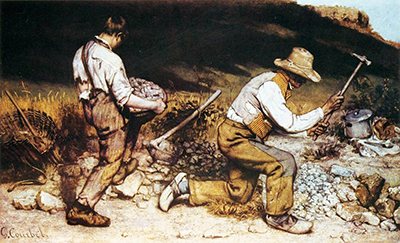The Stone Breakers summarises just precisely what we remember Gustave Courbet for - honest depictions of rural life. He led a form of realism and challenged the norms of the day who had a very different idea about what content art should and shouldn't cover.
Courbet grew up in rural France and whilst achieving success in Paris, he never lost his original roots. He was at his most comfortable within the countryside and would return to it after several years living in the French capital. Courbet produced many portraits of rural people going about their daily lives, feeling it important to capture those with whom he grew up, as well as the beautiful regions in which he lived. Traditionalists branded these works ugly and unsuitable, preferring an unrealistic but idealistic depictions of people instead. Courbet was a strong character who felt comfortable in challenging these norms, though this resistance in France continued throughout his lifetime.
Les Casseurs de pierres, to give it it's original French title, was completed in 1849. Sadly, it was to become one of the most famous paintings to be destroyed during WWII, a period of which did great damage to much of Europe's finest art. Thankfully, there is enough documentation and photographs of the work to still enjoy it today, even if not actually in person. The original dimensions of this artwork was 170 cm × 240 cm (65 in × 94 in) and it was completed in oil on canvas, just as with most of this artist's paintings. Its destruction, ironically, was when being transported in order to better protect it, but it was never to arrive at the intended destination.
This painting communicates the tough lives experienced by many in the countryside. We see a huge rock being carried, whilst another man grinds down these into stones. The clothing and boots are rugged, giving an impression of being uncomfortable, though necessary for this type of gruelling manual labour. There have been other cases of artists addressing the lives of 'ordinary folk', even previously to Courbet, but it certainly was not commonplace within Europe. In some cases there have been links to socialism which laid behind these decisions, and Courbet himself was left-leaning politically. You will find similar in the work of 20th century Mexican muralist, Diego Rivera. Flemish painter, Pieter Bruegel painted some more upbeat and celebratory depictions of peasant life.




